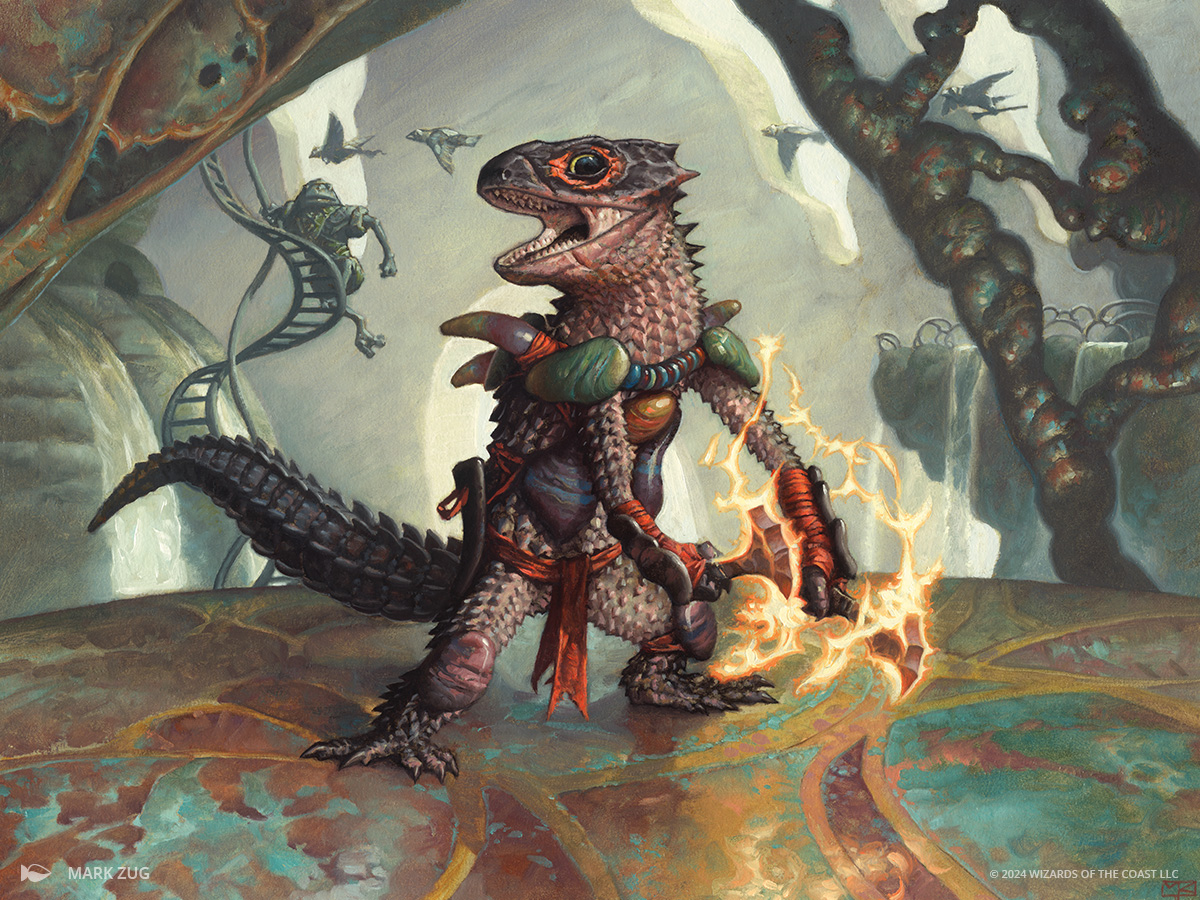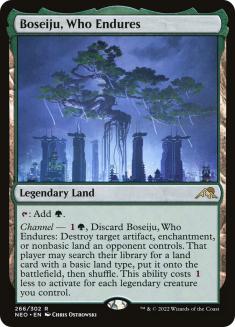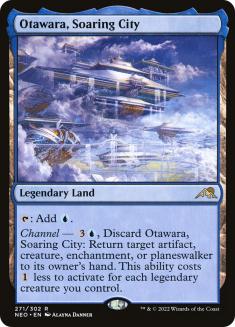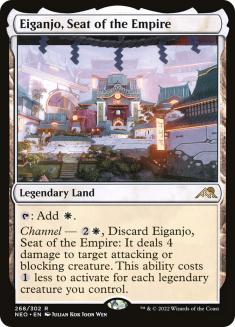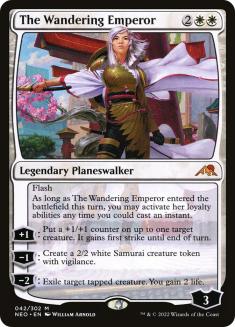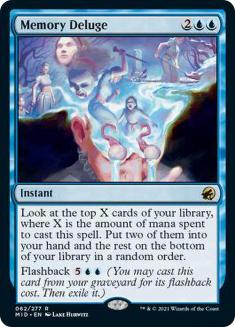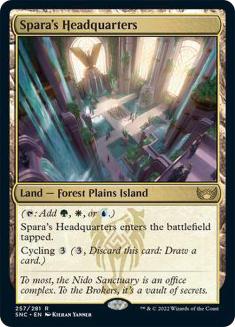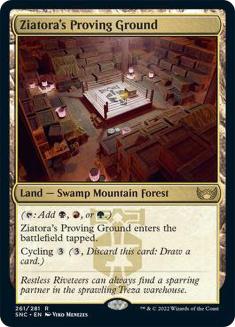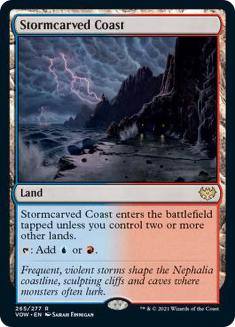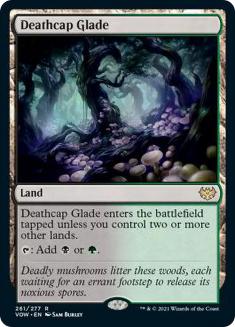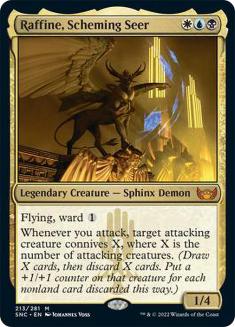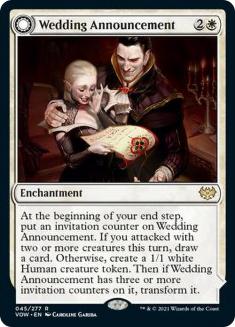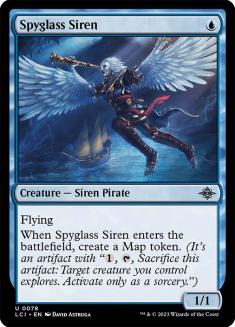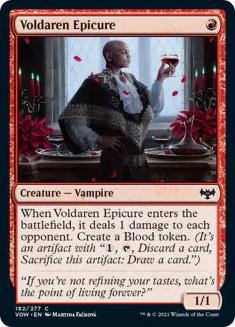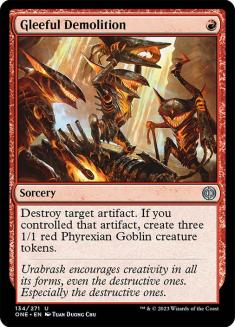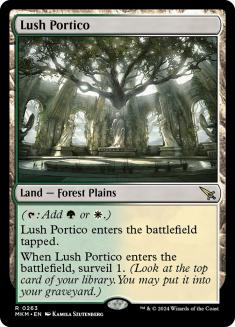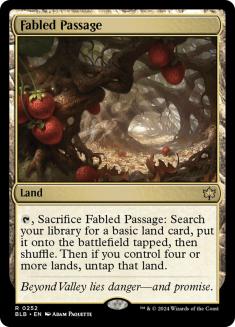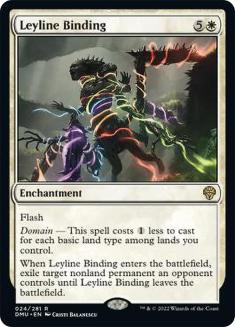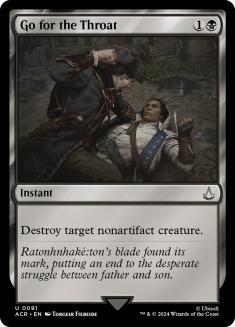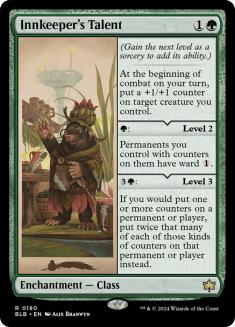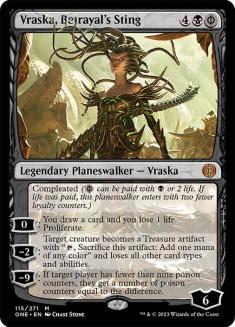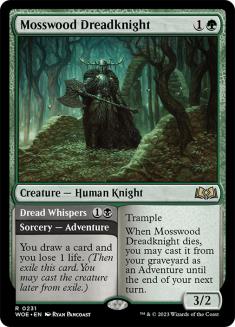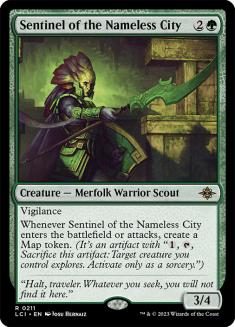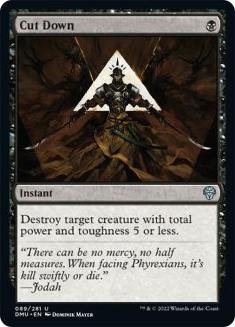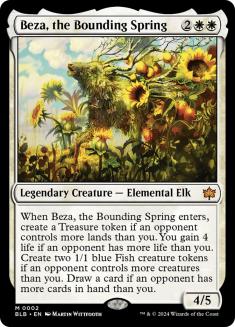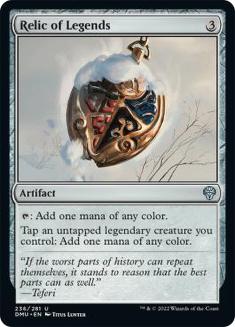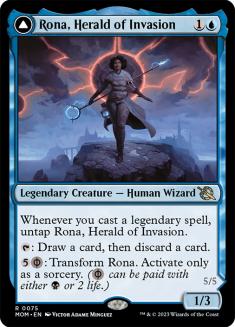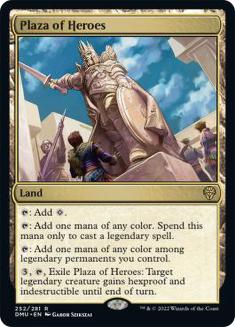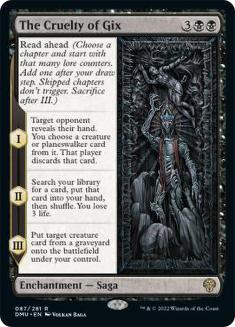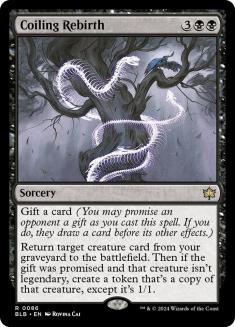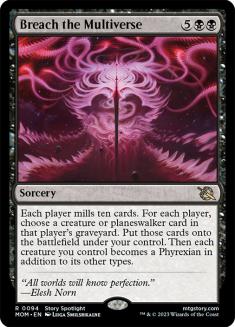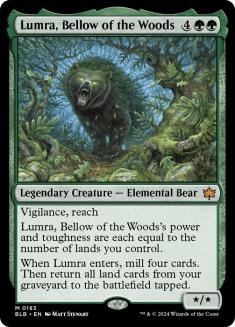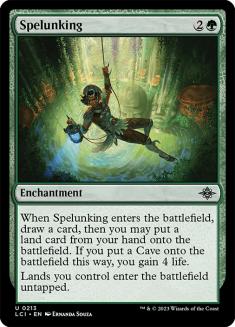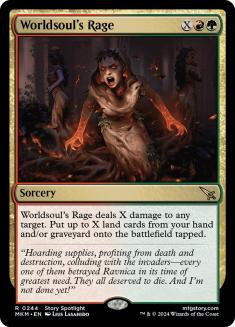Beneath all the doom and gloom about how warped Modern and Legacy are or how stagnant Pioneer is, the start of August saw a seismic shift in the smallest (and now even smaller!) Constructed format. The release of Bloomburrow and the rotation of a full year of sets – Innistrad: Midnight Hunt, Innistrad: Crimson Vow, Kamigawa: Neon Dynasty, and Streets of New Capenna – refreshed Standard and offered a new puzzle to sink our teeth into as we wait for this month’s Banned & Restricted announcement to rescue everything else.
Rotation Casualties
Let’s take stock of what we lost. This is the first major rotation since the switch to three-year Standard, and many cards that were originally meant to leave a year ago are finally being ushered out the door. Some were around for so long that they feel like permanent fixtures of Standard, and we will have to adjust to a world without them.
The channel lands are a perfect example – I’ll have to break the habit of automatically adding the ‘free’ Boseiju to any green deck or playing around any blue opponent holding their one Otawara, Soaring City (or talking myself out of attacking into that ‘obvious’ Eiganjo, Seat of the Empire…).
You no longer have to agonize over how or whether to attack into open mana against Azorius Control, knowing that they can punish your (in)decision either way. Memory Deluge is a big loss for blue control decks as a whole and any ramp or combo deck trying to play for a long game or get guaranteed value from its graveyard, like the Temur Analyst decks that were so distinctive in the last Standard format.
The Shard ‘Triomes’ from Streets of New Capenna have left – but who will care most? It was surprisingly rare to see a full Bant or Jund deck – in such a large Standard, you had all the tools you needed in two colours, or you could stretch your mana even further if you wanted. Even Esper Midrange rarely ran Raffine’s Tower by the end – you didn’t need a triland for fixing, and any tapped land had to compete with creature-lands like Restless Anchorage. If anything, this is a much bigger blow to Domain Ramp – though, as we’ll see, it’s certainly not a fatal one.
The ‘slow’ lands leaving without much fanfare illustrates just how deep and strong the fixing in Standard had become. Your Golgari Midrange deck now ‘only’ has Blooming Marsh, Llanowar Wastes, and Restless Cottage, but that’s still more than enough. For the aggro decks like Boros Convoke or the new takes on Izzet Prowess, reliable untapped fixing is all-important, and they get to keep that – nobody is mourning the loss of Sundown Pass!
Casualties of this rotation include a range of staples like Raffine, Scheming Seer and Wedding Announcement, as well as unique build-arounds like Slogurk, the Overslime that won a dedicated following. Whether you want to play a proven, reliable midrange deck or go off the deep end with some funky legends, you have to find new ways of scratching that itch now.
Rotation Survivors
Some decks survive mostly intact and are back for more.
Creatures (28)
- 4 Resolute Reinforcements
- 1 Yotian Frontliner
- 4 Knight-Errant of Eos
- 4 Imodane's Recruiter
- 4 Spyglass Siren
- 3 Sanguine Evangelist
- 4 Warden of the Inner Sky
- 4 Novice Inspector
Lands (22)
Spells (10)

Convoke is still here and still terrifying, but just needs a new lick of paint. Voldaren Epicure was subtly important for setting up your ideal draw, as it made a Gleeful Demolition target that wasn’t tied to the original creature, giving you exactly enough mana plus bodies to cast Knight-Errant of Eos on Turn 2 (whereas a Yotian Frontliner that has to take one for the team directly leaves you one short). Preserving that option means splashing a whole colour for Spyglass Siren rather than just replacing Epicure with Frontliner or Skrelv, Defector Mite or some other artifact creature.
Luckily, that’s a move some people wanted to make already – and this splash opens up blue’s usual sideboard hits like Negate or Disdainful Stroke (or Protect the Negotiators!) for the sweepers and roadblocks that opponents need to survive. The mana is a little unstable but doable – the full twelve fastlands go a long way there.
Creatures (7)
Planeswalkers (2)
Lands (26)
Spells (25)

Domain Ramp was the most consistent presence through the past year of Standard and shows no signs of slowing down. The ramp suite has to adapt – Topiary Stomper rotating leaves that hole to be filled, and in turn makes Invasion of Zendikar less appealing – but the threats, answers, and card draw are all intact.
The big question was whether losing the Triomes would harm the manabase too much – so far the surveil lands like Lush Portico have risen to the occasion, and the return of Fabled Passage in Bloomburrow was perfectly timed. Domain Ramp never had much trouble with its coloured mana requirements – it was essentially a modest Bant deck with only a very light touch of red and black, so Spara’s Headquarters and all the green fixing were more than enough – but Triomes were vital for getting the actual basic land types for Domain.
This was mostly relevant for Leyline Binding, which takes a big hit with the rotation. The right pair of Triomes could let you cast Binding as early as Turn 2 – Jetmir’s Garden plus Raffine’s Tower, for example – but now you can cast it on Turn 3 at the earliest and often for two or more mana. Triomes let you tick the box for the missing Mountain or Swamp without even trying – you have to go out of your way to search up an actual Mountain now.
Binding is still a premium removal spell and a big draw to the deck, but you can’t rely on it as early interaction these days – luckily, the sweepers and lifegain that are still the backbone of the deck survive the rotation and can hold the fort.
It’s natural that Domain is succeeding in this exploratory phase, as it carries over a proven template from the previous format and exploits the midrange decks that people love to build with the new cards, but I expect it will remain a litmus test in Standard for a while yet.
New Contenders
Once we step into the unknown, we find a highly novel way to go big:
Creatures (17)
- 3 Elesh Norn, Mother of Machines
- 2 Atraxa, Grand Unifier
- 4 Vaultborn Tyrant
- 4 Spinewoods Armadillo
- 4 Harvester of Misery
Lands (25)
Spells (18)
Sideboard

This brew from a Japanese tournament, brought to Magic Online (MTGO) by Anthony Lee, reads like a competitive player’s satire of Commander – but it works! It’s less consistent than Domain Ramp in one sense, but has a simple and effective goal: throw haymakers at the opponent and then throw more. Beating one Atraxa, Grand Unifier is hard enough – can you beat two Atraxa triggers via Elesh Norn, Mother of Machines, or the Push // Pull found by Atraxa that brings it back (with a friend!) for another round?
Elesh Norn is a highlight here – against other ‘go big’ decks (Domain Ramp or the artifact contraptions we’ll see shortly), it disables most of their threats and answers alike while turbocharging your own, and it’s cheap enough that it doesn’t clog up your hand with your other seven-drops. It also slams the door against Jeskai Convoke, where it shuts down almost every card, from cheap setup creatures to finishers like Imodane’s Recruiter or Knight-Errant of Eos.
Creatures (6)
Lands (25)
Spells (29)

How about artifacts? Artifact removal is in short supply, and there are no other reasons to run it, so your value trinkets have free rein to create an engine that is impossible to outgrind in a fair game. This deck weaves together the craft mechanic from The Lost Caverns of Ixalan, the artifact payoffs from The Brothers’ War, and the Treasures buried in the proverbial vault in The Big Score – a great advertisement for how these themes can receive deep support in a bigger Standard.
This deck is contextually powerful too – when the go-to removal spell is Go for the Throat, it becomes shockingly hard for the black midrange decks to remove a giant Construct from Simulacrum Synthesizer, or even a humble Thran Spider.
Even the midrange deck of choice has a combo finish that can steal games in style:
Creatures (17)
- 1 Sheoldred, the Apocalypse
- 2 Glissa Sunslayer
- 4 Mosswood Dreadknight
- 4 Deep-Cavern Bat
- 1 Aclazotz, Deepest Betrayal
- 2 Preacher of the Schism
- 1 Bristly Bill, Spine Sower
- 2 Caustic Bronco
Planeswalkers (3)
Lands (26)
Spells (14)

Innkeeper’s Talent enhances everyone in the vein of Luminarch Aspirant, making your big and sticky threats even bigger and even stickier. This wouldn’t be enough by itself – you’d expect to find this on the fringes making mischief with Ozolith, the Shattered Spire and Botanical Brawler instead – but the final chapter lets you live the thrill of Doubling Season with any counters.
This means that planeswalkers enter with twice as many counters, often ready to use their ultimate immediately – Vraska, Betrayal’s String puts the opponent to nine poison, but Talent adds the tenth for the coup de grâce. Even if you can’t sink mana into Talent for now, Vraska’s proliferation pairs perfectly with all the counters from Talent, Map tokens, and more.
You get to surround that combo with solid, reliable midrange cards that have done good work in much less showy Golgari decks in the past.
Creatures (4)
Planeswalkers (1)
Lands (25)
Spells (30)

Classic control looks promising too. The counters and sweepers here are top-notch, but the key is one of Bloomburrow’s breakout stars:
Timely Reinforcements was one of the best anti-aggro cards of all time for control – Beza lives up to that legacy, but does so much that at least one condition will be met against most decks at most times, making it easy to maindeck and a decent draw against anyone. If you fall behind in a slugfest against a midrange or control deck, a 4/5 that draws a card and makes a Treasure is a legitimate threat!
On the aggro front, it’s no surprise to see decks with all the playable red cards mashed together, but there’s some more variety too. Most sets spawn some new aggro deck based around their central theme or mechanics, but these rarely live up to the hype. Remember the success of Gruul Werewolves after this most recent trip to Innistrad? If you do, you’re imagining things – it flamed out after a week!
Can Lizards avoid that fate?
Creatures (31)
- 2 Laughing Jasper Flint
- 4 Fireglass Mentor
- 4 Iridescent Vinelasher
- 4 Hired Claw
- 4 Thought-Stalker Warlock
- 4 Gev, Scaled Scorch
- 4 Flamecache Gecko
- 4 Valley Flamecaller
- 1 Ravine Raider
Lands (23)
Spells (6)
Sideboard

Rakdos Lizards is capable of some terrifying starts and sports a low curve with good removal, but the main selling point for me is the land base. If you commit hard to one creature type, Cavern of Souls is phenomenal as the third ‘dual land’, while Mudflat Village and Rockface Village are both untapped lands for curving out and mana sinks when the action dries up.
New Frontiers
I’m sure this is just the beginning – we’ll see a lot of weird and wonderful brews over the coming weeks. As I help friends prepare for their upcoming Standard tournaments, I know where my mind might wander…
The legends core from Dominaria United that vaulted Slogurk, the Overslime to Pro Tour glory is still around, even if my beloved Ooze has dried up, and there are many ways to realize Relic of Legends’s potential as a broken mana engine. You can choose a life of crime with Tinybones Joins Up and Vial Smasher, Gleeful Grenadier alongside Marchesa, Dealer of Death or tear through your deck with Glarb, Calamity’s Augur. With Kitsa, Otterball Elite joining Rona, Herald of Invasion, you now have two incredible two-drop looters, so Inti, Seneschal of the Sun can join the fray again, and that gives you yet another discard outlet for any graveyard shenanigans – and there are a lot of those on offer too!
Some form of Reanimator is a tried-and-true way to go over the top of everyone else going big, and each set teases you with more ways to do that. The Cruelty of Gix for Atraxa is old news – how about Coiling Rebirth for a pair of Vaultborn Tyrants that each trigger off each other?!
Temur Analyst as we know it left with the Streets of New Capenna common fetchlands, but all of the ramp pieces and payoffs are still there, and Lumra, Bellow of the Woods is a really big Aftermath Analyst – you just have to figure out how to fill your graveyard. Fabled Passage is certainly a good start…
This first taste of new Standard leaves me wanting more – hopefully I get to dive in again before long!
***

SCG CON is coming to Tampa, FL on September 6-8! The world’s premier trading card game convention features three full days of Magic: The Gathering, Flesh and Blood, Disney Lorcana, and Star Wars Unlimited action:
- Magic: The Gathering Modern $10Ks on Friday and Saturday; cEDH $5K; Super Sunday Regional Championship Qualifiers in Standard, Pioneer, and Modern; and Commander Celebration
- Flesh and Blood Rosetta World Premiere, Calling, and Battle Hardened events
- Disney Lorcana Core Constructed $2K and $1K events
- Star Wars Unlimited Premier Constructed $2K and $1K events
- Side events all weekend long
And so much more!
Plus, meet fan-favorite special guests and artists!
Best of all, SCG CON is free to attend!
Make your plans for SCG CON Tampa!

